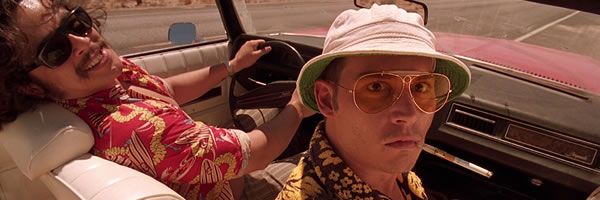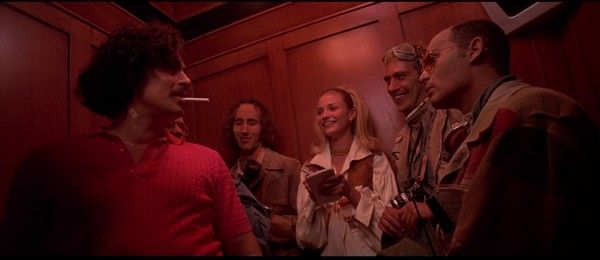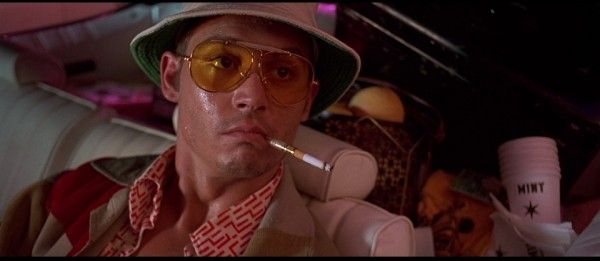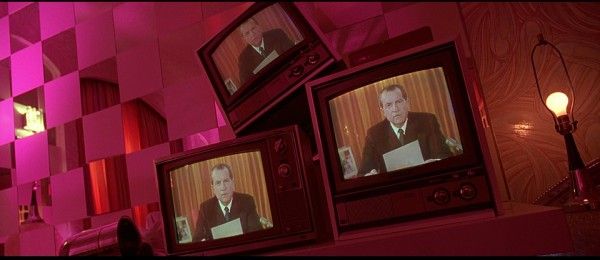Terry Gilliam is one of the most undeniable directors to ever work in the medium. I say that in the sense that when you watch his films you feel the master’s fingerprints all over, and sometimes that makes the film a bit blurry. Gilliam is one of those directors that it is often hard to relax into because he’s so there; it’s hard to ignore what he is doing. Which is why The Fisher King strikes as one of his strongest works in the sense that it is accomplished without shoving itself down your throat. He was brought in last minute to direct an adaptation of Hunter S. Thompson’s novel Fear and Loathing in Las Vegas, and took the project up only to have stars Johnny Depp and Benecio Del Toro already locked in as his leads, had to rewrite everything that came before, and do it (perhaps as it should be done) as a no-holds barred, gonzo, “let’s shoot this fucker” kind of film. My review of the Criterion edition of Fear and Loathing in Las Vegas on Blu-ray after the jump.
Johnny Depp stars as Raoul Duke, the main character of the film and surrogate for Dr. Hunter S. Thompson, who is on the road to Vegas with Dr. Gonzo (Benecio Del Toro). Both are out of their mind on drugs. There’s some mescaline, acid, marijuana, cocaine, LSD and ether for starters, along with booze and all sorts of other things along the way.
Duke/Thompson heads to Vegas to cover a sporting event, and then a cop conference, but the real text is his massively fucked up state of being, with side trips to said events. Duke’s body is in a state of flux, and Depp plays Thompson as a velociraptor. This is fitting because when Duke/Thompson hallucinates he sees lizards, in keeping with the artwork of the book, keeping with the Ralph Steadman look.
It’s unfair to spoil, so if you haven’t seen the film I’m sorry, but what makes the film is a moment toward the end when Thompson is writing and suggests that whatever made the end of the 60’s special and all the revolution, and all the peace and love had/has shit the bed, and the idea that was so appealing about all of that was lost and gone, and turned into something unsavory, much like the trip he is on. That’s the moment the film coalesces, kicks you in the ass, and it’s built to and earned. That said, much of the film is about watching people on drugs, and that has its limits if you have no empathy to people acting stupid. That Gilliam captures a sense of being totally fucked up is neither here nor there. Watching people on drugs has always been way less interesting than being on drugs.
As per Gilliam’s touch, that the master’s hand is readily visible here works as the film is so narrated (how could it not be) that being sentient of an authorial control comes with the territory. This is one of his best films because he manages to capture the book, and still make a Gilliam film. He also loads it with cameos, from Flea, Thompson himself, Cameron Diaz, Tobey Maguire, Christina Ricci, Ellen Barkin, Gary Busey, Mark Harmon, Michael Jeter, Lyle Lovett, Craig Bierko, Penn Jilette, and Harry Dean Stanton among others. This would be distracting if the artifice weren’t so necessary.
The Criterion Blu-ray presents the film in widescreen (2.35:1) and in 2.0 and 5.1 DTS-HD. The transfer is better than the previous Universal Blu-ray, and was approved by the director. Both are exceptionally clean, but the tweaks Gilliam made enhance the film. The film also comes with three commentaries, the first by director Terry Gilliam, the second with Depp, del Toro, and producer Laila Nabulsi, and the third with Hunter S. Thompson as provoked by Nabulsi. All three commentaries are must-listens.
The previous Universal release had deleted scenes (12 min.) and a “Spotlight on Location” (11 min.). The spotlight isn’t included, but there are three deleted scenes here, now with optional Gilliam commentary, which kick off the section of supplements called “The Film”. They’re followed by seven storyboard sequences, all drawn by Terry Gilliam himself. Then there’s still galleries for the production design, and on-set photos. “Depp-Thompson Correspondence” (14 min.) has Depp on camera reading some of their letters together (while he smokes). “Hunter Goes to Hollywood” (10 min.) shows Thompson interacting with the cast and crew on a set-visit.”Not the Screenplay” offers an audio discussion with Gilliam, co-writer Tony Grisoni and Nabulsi (17 min.) about their battles with the WGA about getting credit for their work (basically if someone’s adapted a book, and new writers come on it’s hard to get credit as the first writers were following the spine of the book). Also in this section is “A Dress Pattern” (1 min.) something Gilliam threw together while he was frustrated, to which he also offers a commentary track. The section rounds out with the film’s theatrical trailer and seven TV spots.
The section of “The Book” starts with a profile of Oscar Zeta Acosta, the basis for Dr. Gonzo. This starts with a biographical photo essay, then a clip of Acosta reading from his book “The Revolt of the Cockroahc People” (30 min.), and then “Thompson on Acosta,” (8 min.) which has the audio recording of Thompson’s introduction for the republishing of Acosta’s books. It’s followed by a Ralph Steadman art gallery, an excerpt from the audio book version (8 min.) featuring Jim Jarmusch as Duke, Maury Chakin as Gonzo, and Harry Dean Stanton as the narrator. Finally there’s a 1978 documentary on Thompson and Steadman called “Fear and Loathing on the Road to Hollywood” (50 min.). This is what is called definitive.
[Blu-ray screencaps courtesy of DVD Beaver]




